Selecting the right email marketing platform is crucial when you want to begin building an email list. MailerLite and ConvertKit are two popular email platforms for niche website owners, so I’m reviewing both to help you make an informed decision if you’re between the two.
Whether you’re a beginner looking for affordability and basic features or an advanced user in need of powerful automation capabilities, we’ll explore the strengths and limitations of MailerLite vs ConvertKit, enabling you to find a good fit for your email marketing needs.
With over 10 years of working on advanced email marketing (both in our agency and on our own websites), I wanted to determine which platform a site owner should use and when.
In reviewing the email marketing platforms in-depth, I’ve shared our thoughts and insights below!
A few caveats: we tried to be as accurate as we could in this review and focus on facts and data when writing this. If something is incorrect, let us know! There are affiliate links to the email platforms in this, but we don’t have specific affiliations with any of them.
Quick Navigation
MailerLite vs ConvertKit
To start, here’s a brief breakdown of the platforms:
- ConvertKit is great for creators and those who want to build powerful automated email workflows.
- MailerLite provides an enticing free plan with several features for those just starting out, along with affordable pricing as you grow.
TLDR – Overall, MailerLite and ConvertKit are similar in the features they offer. In most categories we cover below, ConvertKit is more powerful and robust than MailerLite, but that comes at a higher price point. Take a look at the chart below for a quick overview, and then scroll to the bottom to read the verdict.
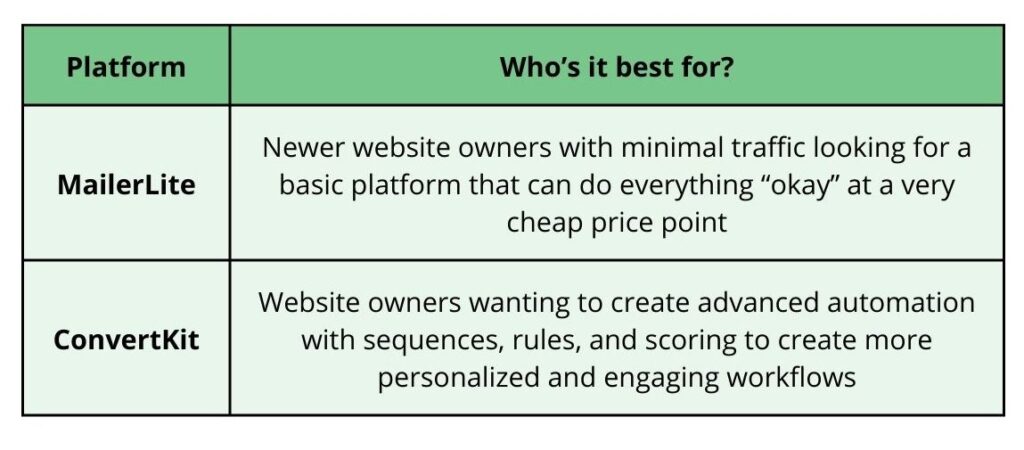
Price
Understanding the price points upfront is crucial, as it directly impacts the options and features available to you. (All pricing mentioned here is based on annual plans rather than monthly subscriptions.)
MailerLite
If you want an email platform that offers a solid range of essential features at an affordable price, you can’t really go wrong with MailerLite. It has a free plan allowing up to 1,000 subscribers.
While ConvertKit also has a free plan for up to 1k subscribers, MailerLite makes their free plan really attractive by giving you access to a ton of great features without needing to upgrade. This includes creating segments, building popups, and launching automated workflows.
While the free plan offers a lot, it’s important to note a few limitations, like the absence of pre-made email templates, the inability to incorporate dynamic content into your emails for enhanced personalization, and a monthly email send cap of 12,000 emails.
However, when the time comes to upgrade and access the additional features, MailerLite’s pricing remains appealing compared to ConvertKit.
Starting at just $9 per month for up to 1,000 subscribers, MailerLite provides a cost-effective solution for scaling your email marketing efforts (it’s worth clarifying that you can continue using the free plan for up to 1,000 users, but opting for a paid plan grants access to advanced functionalities).
As you grow, this is what the pricing looks like:
- Up to 2,500 subscribers: $15/mo
- Up to 5,000 subscribers: $29/mo
- Up to 8,000 subscribers: $31/mo
- Up to 10,000 subscribers: $47/mo
- Up to 15,000 subscribers: $77/mo
MailerLite is the more affordable option as you work on growing your list, compared to ConvertKit. It includes a bunch of features, and they are all decent.
ConvertKit
Similar to MailerLite, ConvertKit provides a free plan with up to 1,000 subscribers. It’s worth noting that while on the free plan, you won’t have access to building automated email sequences, which play a crucial role in maximizing your email marketing efforts.
ConvertKit excels in its capacity to create intricate and powerful automations, making it a standout feature. To use this feature, along with other advanced functionalities, pricing begins at $25 per month for up to 1,000 subscribers.
From there, the pricing increases (and quite a bit more than MailerLite):
- Up to 3,000 subscribers: $41/mo
- Up to 5,000 subscribers: $66/mo
- Up to 8,000 subscribers: $83/mo
- Up to 10,000 subscribers: $100/mo
- Up to 15,000 subscribers: $125/mo
So, who should consider this platform based on its pricing? It caters to individuals who prioritize the creation of sophisticated automation workflows aimed at providing a very personalized experience to every subscriber on their email list.
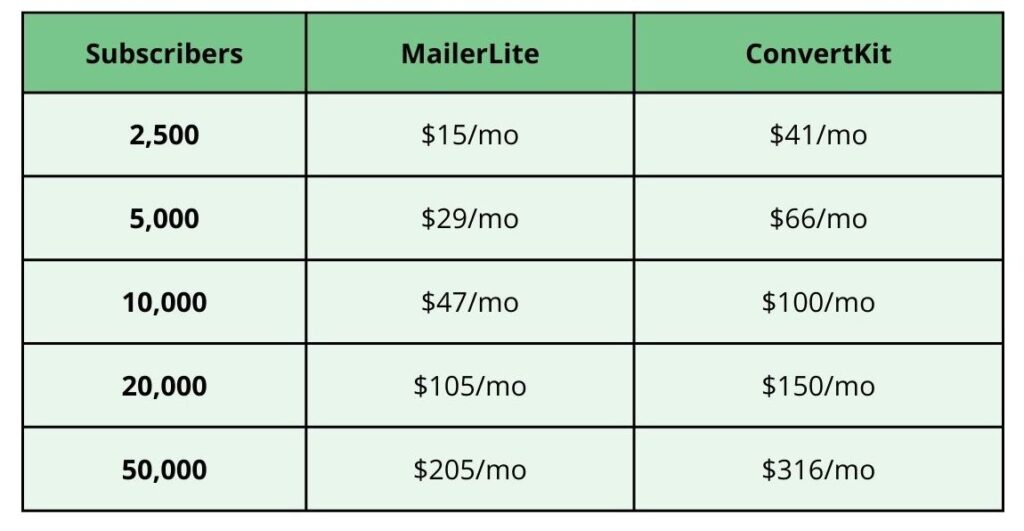
All prices based on annual billing
Segmentation
Segmentation is important because it allows you to group your contacts based on who they are, what they’re interested in, or various actions they take with your content. For example, you might categorize email subscribers by where they live or certain emails they’ve opened.
People have a short attention span, and by creating emails that are tailored to various segments, you have a better chance of them reading and engaging with your emails.
You can’t get super complex in the segments you create; however, you can still filter by criteria like location, the date they signed up, the number of email opens, or how they filled out a specific custom field.
And, the even better news is that you can access the segmentation features in both MailerLite and ConvertKit’s free plan.
Automation
Automation is a highly effective email marketing technique that can yield exceptional results when implemented correctly. I personally love creating automated email series that subscribers can join to keep them engaged with content they’re actually interested in.
Both ConvertKit and MailerLite do pretty well in this category, far better than beehiiv.
MailerLite
MailerLite’s automation workflows, while not exceptional, offer a decent amount of functionality. With basic triggers and conditions, you can create most types of workflows you’d need as you start and grow your list.
It’s worth noting that MailerLite has made significant improvements to its workflows over time, so it’s possible that they continue to improve this feature on the platform.
While ConvertKit’s automation is more powerful and you can design more intricate workflows compared to MailerLite, the advanced functionality is not really necessary if you’re just planning to build out basic workflows.

ConvertKit
Overall, if your priority is automation, ConvertKit is a great platform to sign up for.
ConvertKit excels in offering robust and powerful automation capabilities, although it may not reach the same level as an advanced marketing tool like Hubspot.
What sets ConvertKit apart is its workflow integration of audience tagging, segmentation, and scoring, which allows you to create highly targeted and custom email workflows for specific audiences within your subscriber base.
By tailoring the user experience based on individual engagement within the workflow, ConvertKit enables you to better understand your audience, provide them with relevant content, and gain more trust, ultimately increasing the likelihood of conversions.
Unlike MailerLite, you need to be on a paid plan to access automated email sequences with ConvertKit. Again, if you’re planning to prioritize automation as a strategy, then paying for this feature is worth it. If you’re just wanting to try out automation, then experimenting with it on MailerLite’s free plan might be the better option.
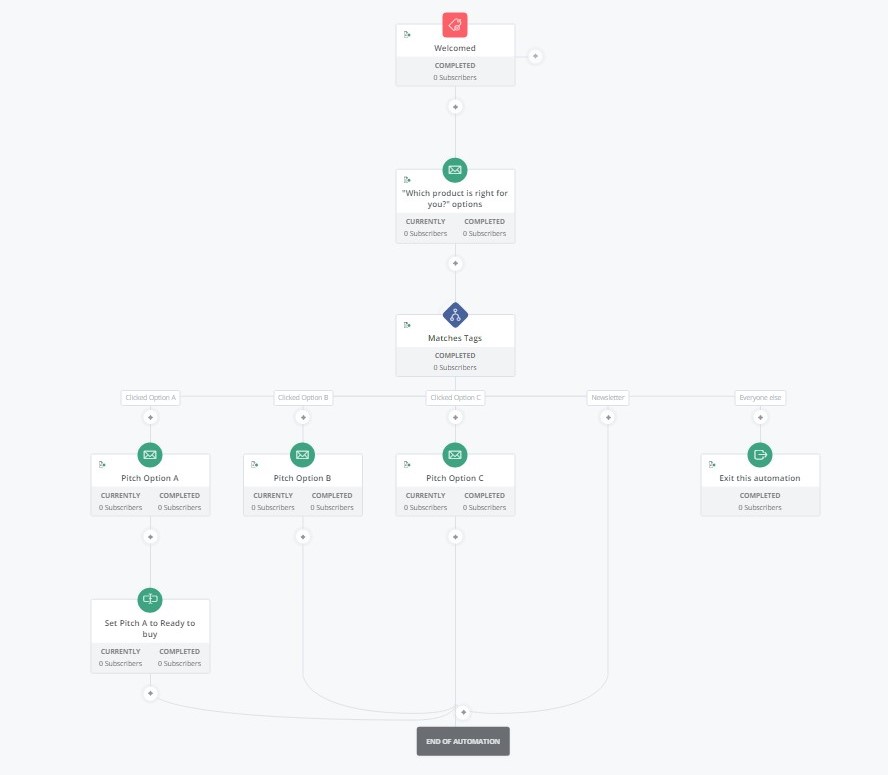
Deliverability
Deliverability plays a pivotal role in the effectiveness of your email campaigns. Even if you write an awesome email with a nice design, all that work is pointless if it fails to reach your recipients’ inboxes.
Now, there are several factors that can impact whether or not your emails make it into someone’s inbox – it’s not just determined by the email software you’re using. For example:
- Are you sending emails from a custom domain or relying on a generic Gmail, Yahoo, or AOL address?
- Have you taken the necessary measures to authenticate your email domain?
- Are you utilizing a dedicated or shared IP address?
- Are you writing spammy-sounding subject lines that trigger red flags?
Additionally, the level of engagement your emails generate, reflected in open and click rates, can impact deliverability. Even if your emails make it to the inbox, being marked as spam by a user can have negative consequences and impact future deliverability.
While there may be slight variations in opinions when it comes to good email deliverability rates, you want to aim for around a 90% deliverability rate.
EmailToolTester provided stats on email deliverability for ConvertKit and MailerLite, and you can see in the chart that they found that 75.8% of MailerLite’s emails end up in the main inbox, compared to 70.3% of ConvertKit’s.

In general, they both need work on improved deliverability rates, especially when looking at ConvertKit’s spam score.
Popups and Forms
Popups and embedded forms are valuable tools for lead generation on your website. By strategically placing popups, you can capture visitors’ attention and entice them to provide their email addresses, enabling you to grow your subscriber list.
These popups on the website and embedded forms in WordPress can offer incentives such as exclusive content, discounts, or free resources, making them a compelling way to convert website visitors into potential customers and expand your email marketing reach.
Overall, ConvertKit and MailerLite are comparable in this category. It’s simple to add and embed forms and popups onto your website, and they integrate seamlessly with several popular CMS platforms like WordPress, Squarespace, and Shopify.
They both have a gallery of templates that make it simple to quickly design forms and popups in minutes. Additionally, you can add multiple fields to them, allowing you to capture valuable information such as first name, location, phone number, etc.
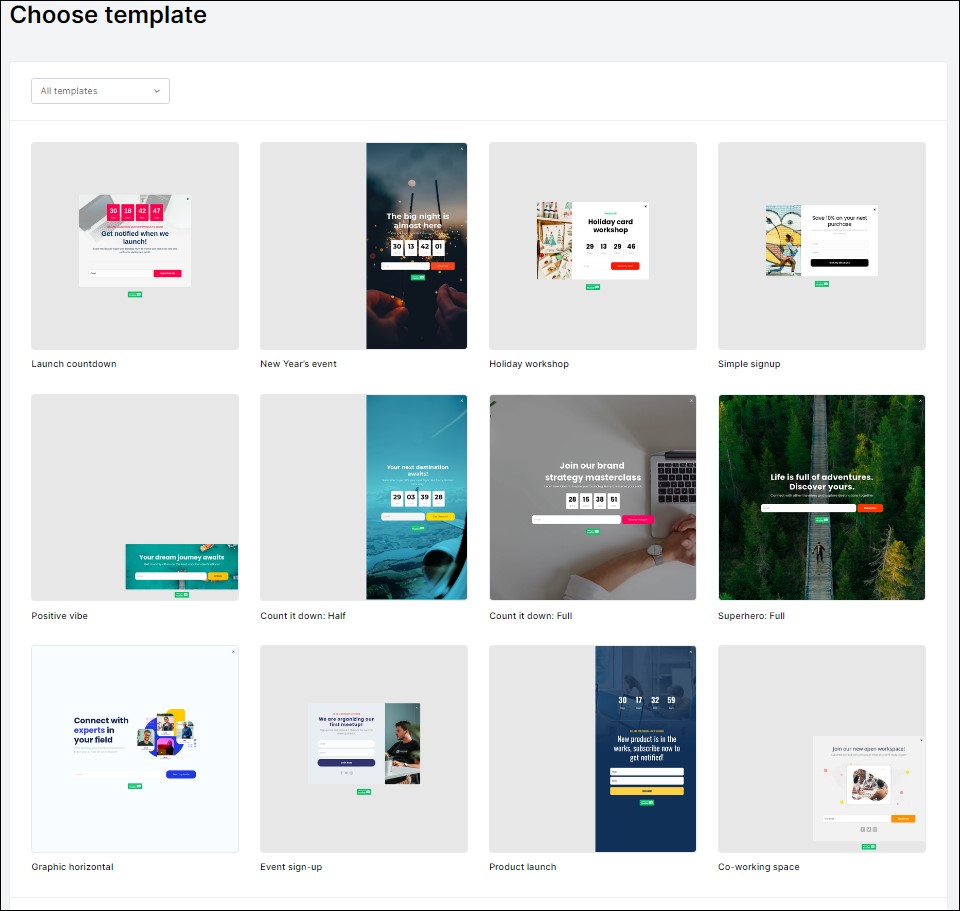
Monetization
When starting out with email marketing, your primary focus is not likely monetization. This makes sense, but as your list grows, monetization is a strategy you should consider to begin making money from your email sends.
Because of this, it’s worth spending time to understand the features and capabilities offered by various email platforms. This allows you to leverage the right tools and strategies to maximize your email campaigns’ effectiveness and potential for generating revenue.
MailerLite
As with most features found on MailerLite, the monetization options are basic. They are fine when you’re getting started and want to see what’s possible as you build your list; however, you’ll likely outgrow what MailerLite has to offer, and it’s not a great long-term option. Some of the ways you can monetize include:
- Offering a subscription to a paid newsletter where you offer exclusive content
- Selling digital products, such as guides or e-books
ConvertKit
When you’ve grown your list (or already have a substantial following), ConvertKit provides more opportunities to monetize than MailerLite.
You can set up paid newsletters and sell your digital products, just like you can in MailerLite. The real upside with ConvertKit is taking advantage of their sponsor network. If you get accepted into this, they’ll identify premium advertisers relevant to your niche, and you can place those sponsorships into your email blasts to make money.
There is a slight catch, though. In order to get into their sponsor network, you must have 10,000 subscribers or more, along with showing that you send an email to your audience at least once per week. Plus, they have a 3.5% processing fee, and they take 20% of the total sponsorship revenue.
Integrations
To quickly touch upon integrations, ConvertKit provides you with more options than MailerLite. Even though ConvertKit offers more, they both integrate with Zapier, which opens up the doors to integrate with hundreds of additional platforms.
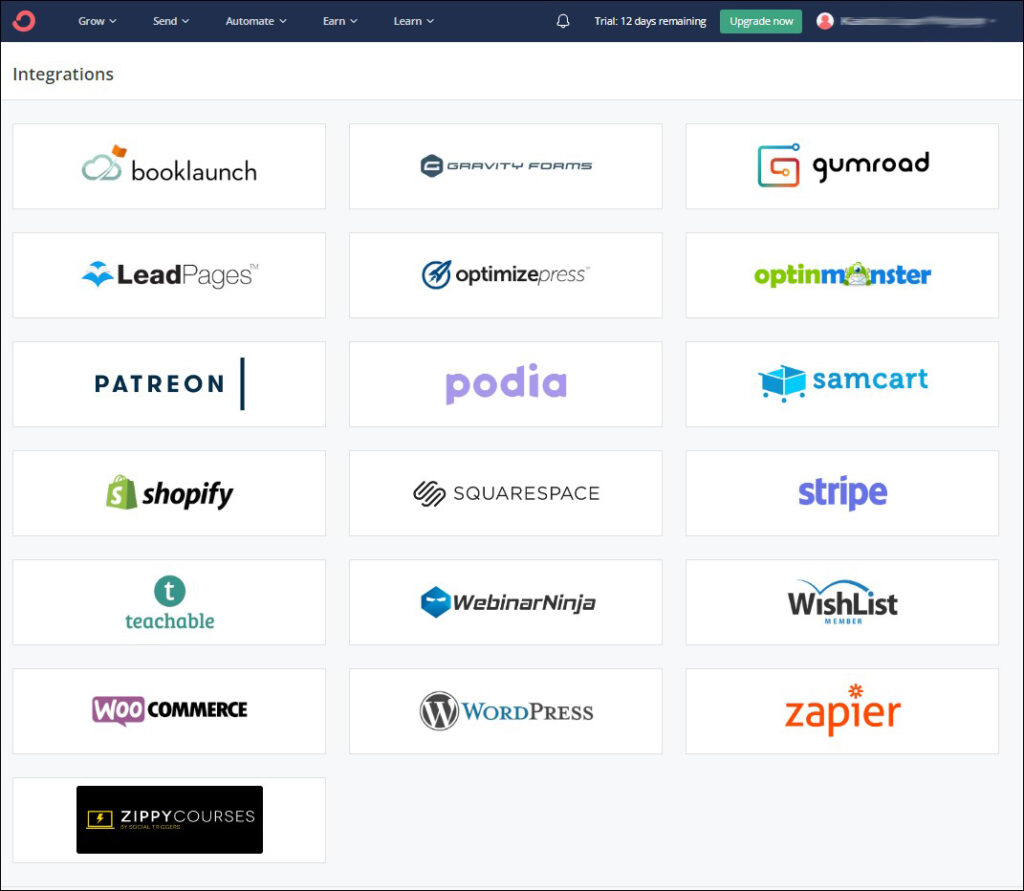
Verdict
So, which email platform makes more sense to sign up for? Here’s what we think:
🎯 We use MailerLite on sites that have minimal traffic, and we continue using it until we gain 5,000-10,000 email subscribers. When it comes to the overall value, MailerLite is the way to go, especially considering all the features you have access to on the free plan. Even when you upgrade to a paid plan, the pricing is more affordable compared to ConvertKit, which is great when you’re in the beginning stages of growing an email list.
🎯 If you have a website with leads that are highly engaged, or you’re focused on getting them to be more engaged through targeted email workflows, ConvertKit is what we recommend. If you’ve grown your email list to a decent size and aren’t as concerned about the pricing (or plan to offset that with monetization strategies), ConvertKit is great.
We can set up your email newsletter for you, including adding a pop up and lead gen e-book! Learn more here!
Final Thoughts
Based on your prerequisites and priorities, here you go!
- Price: MailerLite (cheapest) → ConvertKit (expensive)
- Segmentation: MailerLite and ConvertKit are comparable
- Automation: MailerLite (okay) → ConvertKit (robust)
- Popups/Forms: MailerLite and ConvertKit are both robust
- Monetization: MailerLite (least options) → ConvertKit (more options but pricey)

